A comfortable life in a country house or in a summer cottage implies the availability of water supply and sanitation. If there are no central communications in SNT or a cottage village, it is necessary to mount the water supply on your own or with the involvement of a contractor. The owner of suburban real estate must clearly understand what materials to choose. The metal pipes were replaced by plastic pipes for water supply in the country. Their consumer qualities are well suited for laying outdoor and indoor routes and arranging an irrigation track for a vegetable garden.
Types of water supply
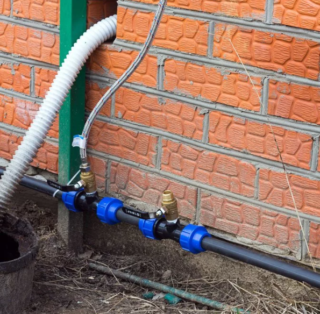
The purpose of the water supply system in a country house can be conditionally divided according to the seasonality of use and according to the area of application. If the house is intended for year-round living, then the water supply line is used all-season. When the house serves only for summer holidays, it is subject to autumn conservation, during which it is necessary to drain water from all consumers and drain the water supply. Those who live in arid climates, or grow vegetables, fruit and ornamental plants on their backyard, will need to replace heavy rubber garden hoses with a neat and practical plastic pipe for summer plumbing.
According to the requirements for operation, it is possible to differentiate the water supply system into summer, winter, outdoor. The choice of material follows from the purpose of the line.
Varieties of pipes
Plastic products are used relatively recently. In old houses, water supply was carried out using steel pipes. The main advantage of this material is its mechanical strength. The list of disadvantages is much longer:
- low corrosion resistance;
- complexity of installation;
- high price;
- tendency to form deposits and narrowing of the diameter.
Low frost resistance of the metal system, leads to its failure when freezing. Plastic products are free from these disadvantages. In order to meaningfully choose which pipes to use for water supply in the country, you should familiarize yourself with their characteristics.
Reinforced plastic
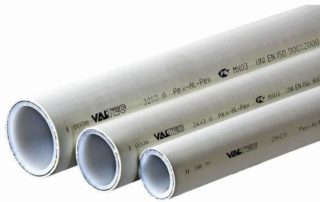
This type of pipe can be used in the device for cold and hot water supply, as well as when installing a heating system. The connection cannot be made by gluing or soldering, you need to use compression fittings, crimp or press. Both varieties are expensive. You can save on fittings by flexing the pipe to avoid an obstacle. Press fittings can be used in hard-to-reach places, but crimp fittings need constant access, because during the operation of a water supply system made of metal-plastic, they can weaken, causing a leak.
Polyethylene pipes
To bring water into the house from a well or well, a low-pressure polyethylene pipe, or HDPE, is most often used. Polyethylene pipes are sold in coils. Each running meter of the product has a marking that allows you to determine:
- appointment;
- working environment;
- manufacturer;
- outside diameter;
- minimum wall thickness;
- pressure limit;
- date of issue and batch number.
In addition to alphanumeric markings, pipes have longitudinal stripes. Blue lines mean the use of a product for cold water supply, yellow lines indicate the purpose of pipes for a gas pipeline.
HDPE does not tolerate heating well, therefore it cannot be used for the installation of heating and hot water supply.
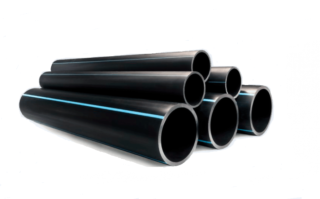
The disadvantages include lower strength compared to metal, so you should not lay a route from HDPE in the place where cars drive.
List of advantages of polyethylene pipes:
- low price;
- chemical resistance;
- biological neutrality;
- perfect smoothness of the inner surface;
- long warranty period of operation;
- the possibility of low-temperature operation - the product can withstand t0 up to -60 С0;
- installation by welding or threaded fittings;
- easy dismantling and the ability to make changes to the circuit.
HDPE plumbing can run along the surface of the soil. For aesthetics, it can be buried a few centimeters into the ground.
When designing a water supply route, it is necessary to calculate the length of the pipe in such a way that it goes underground in a whole piece. The fittings can be tightened by hand without the use of tools. They are designed to withstand the water pressure in the system. Due to the elasticity of the material, when the water freezes, the pipes do not burst; after thawing, they return to their previous shape and size. The HDPE pipeline can be used for water supply of seasonal dachas and for year-round cottages. Despite the fact that polyethylene is a frost-resistant material, in order not to be left without water at the most inopportune moment, the laying of a winter water supply system must be carried out below the freezing point of the earth. This value is a reference, it differs for each specific region of the country.
PVC pipes
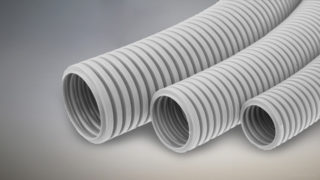
Polyvinyl chloride is used for the production of these systems. The material is flame retardant and chemically neutral. Non-pressure products are applicable in the installation of drainage systems, and for the installation of the supply water pipe, it is necessary to use a pressure pipe that can withstand the pressure of the liquid. The connection of individual elements of the system is carried out using cold welding. A properly glued seam can last half a century. The cost of a PVC water supply system is higher than that of HDPE, and the consumer qualities are somewhat worse:
- temperature range from -15 to +45 С0;
- negative reaction to freezing, the material becomes brittle and less elastic;
- decrease in operational properties with prolonged exposure to ultraviolet radiation.
- the complexity of disposal.
The occurrence of scratches dramatically reduces the strength of the products, therefore, the use of PVC pipelines in external routes is impractical. It is impossible to cut threads on pipes made of polyvinyl chloride, and therefore the process of tying equipment is difficult.
Advantages of PVC piping:
- easy installation;
- smoothness of the inner surface;
- chemical neutrality;
- incombustibility.
The main area of application is the sewerage device.
Polypropylene pipes
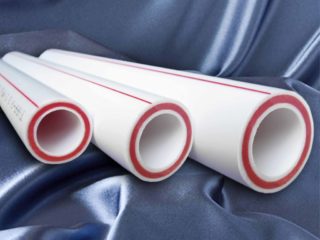
Produced by the industry in two versions - for cold and hot water supply, as well as for heating. The marking with a blue stripe along the length of the product indicates the possibility of using it in a cold environment, and the red stripe allows the pipe to be used in hot water supply systems and for transporting coolant. Reinforcement of the pipe with aluminum allows several times to reduce the coefficient of thermal expansion. Polypropylene is very tough, products made of it cannot be bent, so the system is assembled using fittings by soldering. A special soldering iron is used for soldering, which can be rented at a hardware store. The heated pipe is inserted into the heated fitting and fixed. After a couple of minutes, the connection becomes monolithic.
During installation, it is necessary to observe the connection depth: if it is insufficient, it is possible to leak, if it is excessive, it will narrow the inner diameter.
The material has all the advantages of plastic pipes:
- low price;
- smoothness of the surface;
- chemical neutrality;
- corrosion resistance;
- long service life;
- durability and reliability.
The disadvantages include the need for soldering, but this process is not so complicated. To master the technique, it is enough to practice on pipe scraps.
Selection recommendations
Based on the properties of each of the materials considered, it is possible to give a recommendation for the installation of a water supply system:
- It is better to use HDPE pipes for a watering line on the street and for a water supply system that goes from a well or a well to a house.
- The internal cold and hot water supply system can be assembled from polypropylene pipes by choosing products with the appropriate marking.
- For heating, you should take reinforced polypropylene pipes.
- For drainage, it is worth using PVC products.
Observing the rules of installation and operation, you can ensure uninterrupted water supply and wastewater disposal in a country house.








